The year was 1984.
Apple’s first Macintosh computer went on sale in January and Marvin Gaye was shot by his dad in the spring. By the time summer came, the Soviets had decided to boycott the Olympics, and by December, was still a thing. Meanwhile, in Windsor, the Chrysler Corporation had learned how to legitimately manufacture money.
Introduced in late 1983 before going on sale early in ’84, Chrysler’s ascendant minivan would ultimately assassinate the station wagon in North America, supplanting it as the family hauler of choice and ultimately saving the Corporation from certain financial doom.
Initially developed as a derivative of the K-Car, the minivan permanently altered the North American passenger car game, offering suburban families the choice of five or seven seats, removable seating, cargo capacity, fuel efficiency and car-like behavior. Dodge, Plymouth, and Chrysler-branded versions of would rule supreme in suburbia for almost three decades, selling it was such a symbol of banal conformity and just so practical.
ALSO SEE: 2017 Chrysler Pacifica Hybrid Review
More than 14 million vans would find new homes across five generations of product, but growing stigma and something called the Crossover Utility Vehicle had started threatening the cash cow. If FCA wanted to rekindle the fire it started, both the product and the production process would need a revamp.
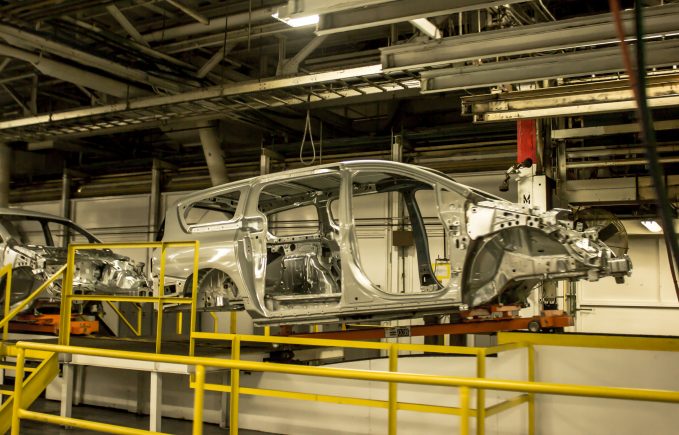
Rumors started bubbling in 2013 that Chrysler was planning to introduce a replacement for the Town & Country in three or four years time, but it was believed the new evolution could morph into something like the Chrysler Pacifica, an SUV based on minivan bones.
Whatever it would be, the company was serious about making it successful, with Sergio Marchionne promising more than $2-billion in investments dedicated to the development and production of a new vehicle in Windsor.
Enter the Chrysler Pacifica. .
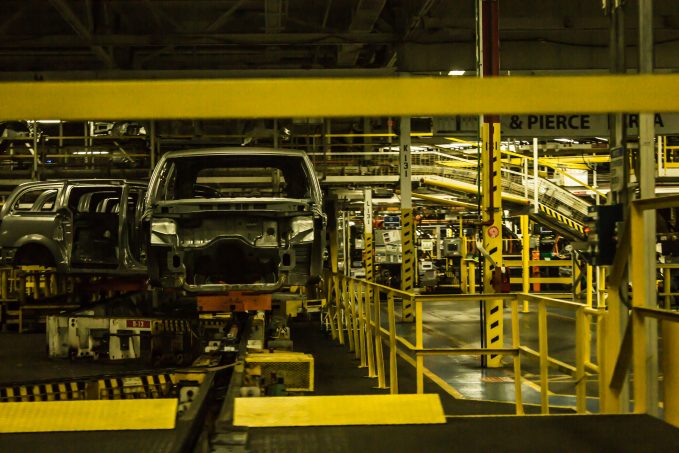
The reimagined Pacifica does its best to meld both concepts, its “all-new” platform is once again a warmed-over derivative of one of the company’s bread and butter platforms— in this case, the Compact US Wide (CUSW) platform — to once again offer comfort and efficiency, but now with a new touch of refinement.
The new Pacifica brings a further 37 innovations to a segment Chrysler has long owned. Engineering firsts aimed at not just improving the consumer experience, but winning back the suburban schlepp from the invasive crossover that is quickly cannibalizing the industry.
Of the $2.6-billion allocated to the Pacifica program, nearly $1-billion was used to upgrade and retool Windsor Assembly. KUKA Assembly’s PULSE line system was chosen for its flexibility and durability, it uses electric friction motors which are more reliable and require less maintenance than a conventional line system. The new line also fits within a smaller footprint and offers more flexibility, which is the key to producing distinct vehicles on the same line.
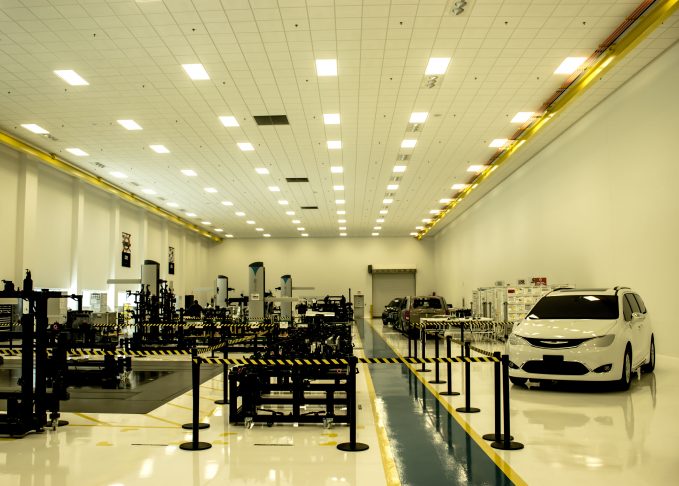
In order to up production quality and eliminate waste, a new Metrology Center was added, allowing for Complete Technical Vehicle Validation (CTVV) using 3D scanning and laser imaging technology. The gleaming white department could build itself a Pacifica if necessary, but more importantly, it finds problems. Allegedly, it was the metrology team that briefly halted production of the Pacifica Hybrid earlier this summer after discovering a problem with the battery’s inverter diodes.
Combining Windsor’s new magic weapon with upgraded line equipment and streamlined processes allow the Pacifica and Grand Caravan to coexist on the same line with little commonality. The Pacifica pair shares the exact same space and station times with the Grand Caravan, each taking 26.1 hours to go from a pile of bare metal stampings into a fully functional product on its way to the dealership.
ALSO SEE: 2017 Chrysler Pacifica Review
Involved in the hustle and bustle are some 6,000 employees spread out over 4 million square feet between three buildings, and linked by 40 km of conveyor chain that drags the vans through the complex from start to finish.
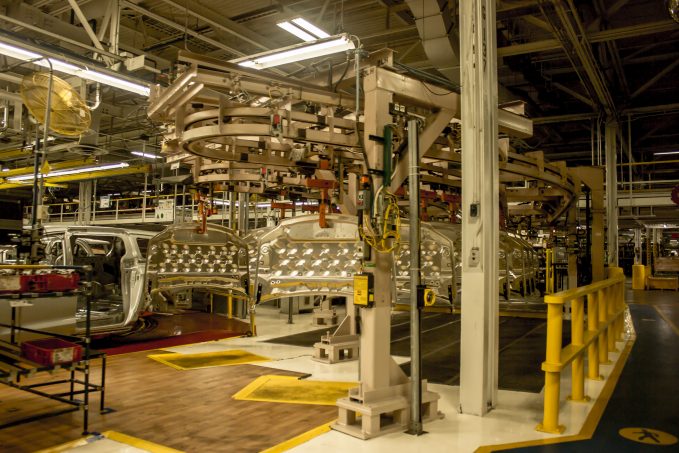
Everything starts in the body shop building, where a synchronized team of 1,274 robots use a sophisticated array of cameras and lasers to measure and position the panels within 0.5 mm tolerances before welding them in place. Body-in-white production takes a little over eight hours from start to finish before the vans sit for an hour as the rest of the factory gears up for their arrival.
For the next seven hours, the vans are worked over by 453 people and 150 dancing robots, but FCA wouldn’t let us watch. Each van gets primed and painted with its doors in place before they’re removed and sent on their way around the plant separately, being reunited with the body they belong with later on during assembly. FCA says the process is a bit of a pain but makes for a much better paint job.
Trim and Chassis are where the van spends the next six hours of its nascent life. After crossing into the assembly building from the overhead conveyor, 2,500 employees are aided by more than 50 robots, 63 skillets, and 65 chassis palettes to fit the meaty bits and optional sweets each van will roll out the door with. Wiring looms, windows, seats, hoses, wheels, and headliners all find their places in 42-second station intervals.
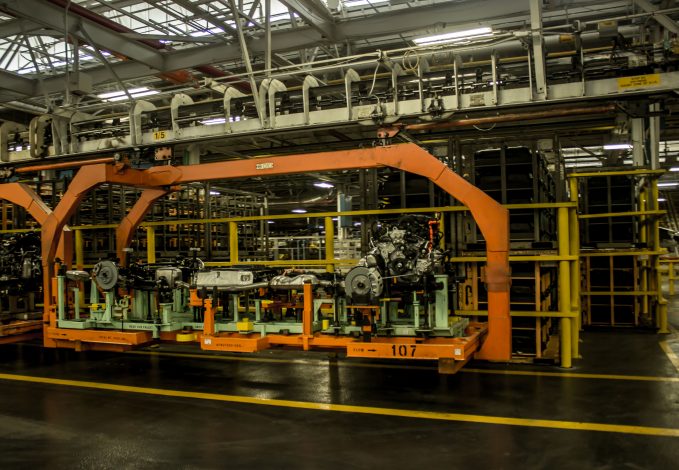
The most mesmerizing of all is when the entire driveline and suspension subframes are married to the body in one fluid motion as the van is lowered and the assembly raises into its new home. The only real difference in production between the Pacifica and Pacifica Hybrid happens at a sub-assembly station that assembles the hybrid’s Atkinson cycle Pentastar V6, electric motors, eFlite transmission, 16-kWh battery pack and suspension into one unit. The entire assembly is then shuffled over to the robots that raise the hybrid powertrain into the descending body just like its siblings, with the battery simply tucking up under the floor where the Stow n’Go seat cavities used to be.
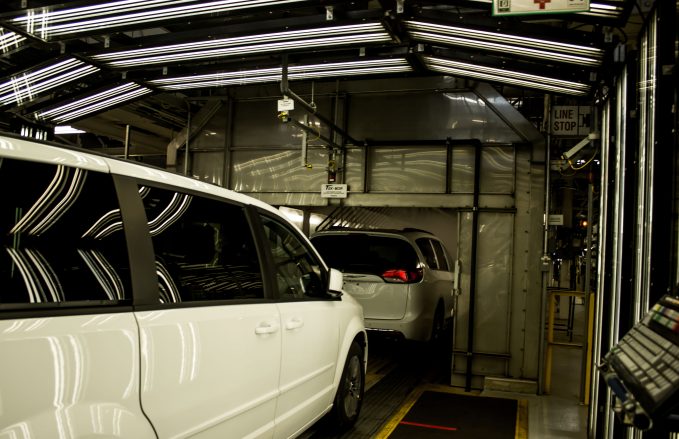
Once the vans roll off the assembly line, measurements are checked one final time before the vans are wheeled over to a crack team of inspectors which give each van a thorough once over, checking for dents, fit, and finish, before sending them through a high-pressure bath that ensures each one is properly sealed. All that’s left is getting them out the door and loaded onto a truck for shipment to a dealership in Whoknowswhere, America, or Whatsthatplace, Canada.
Windsor Assembly will go quiet in early October as FCA retools for and refreshes the Grand Caravan to meet new side-airbag regulations that came into effect in the U.S. on Sept. 1. The Pacifica already meets them.



Leave a Reply